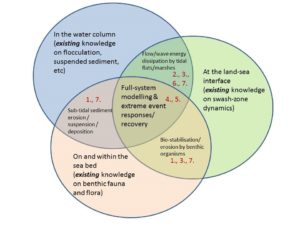PHYSICAL AND BIOLOGICAL DYNAMIC COASTAL PROCESSES AND THEIR ROLE IN COASTAL RECOVERY (BLUE-coast)
- PROJECT OVERVIEW
In the UK, strategic guidance for coastal management is provided through Shoreline Management Plans (SMPs: England and N. Ireland) and developing “Regional Marine Plans” (Scotland). These provide a large-scale assessment of the risks associated with coastal processes and a policy framework to reduce risks to people and the built and natural environment. These policies need to be underpinned by robust scientific evidence on both coarse- and fine-grained sediment dynamics (gravel, sand, mud). However, the complexity of sediment dynamic processes – including coupled physical-biological processes – in the water column, on and within the seabed, and at the water-land interface, are not well understood. As a result, substantial uncertainties characterise the prediction of medium-term (years) and long-term (decadal and longer) regional sediment budgets and coastal morphological change. The prime aim, therefore, of BLUE-coast is to reduce those uncertainties and thereby make a meaningful contribution to the delivery of more effective coastal management strategies. Specifically, we identify seven project aims which recognise where current scientific understanding is deficient and relate to the three areas identified in the Announcement of Opportunity that require fundamental ‘scientific advances’ (SA), i.e. (i) better understanding and representation of both transportable and source material within the coastal zone (sediment, biological or ecological characteristics); (ii) quantitative assessment of the flux of transported material, including how this flux is mediated by the ecological system that exists along and within the coastal zone; and (iii) the assessment of sensitivities of this mixed-sediment physical and biological system to possible changes in external forcing in parallel with assessments of behavioural uncertainties. The seven BLUE-coast aims (Figure 1) are to address the following questions:
- What is the role of sediment type (grain size, cohesiveness, lithology, biological characteristic) and coastal geomorphology on mediating coastal evolution? (SA i);
- Which processes dictate the cross-shore and/or alongshore sediment fluxes of sediment from source to sink? (SA i and ii);
- What role is played by biotic factors in the ecosystem and to what extend do biotic processes mediate coastal change or stability? (SA i and ii);
- Which processes govern the recovery period of coastal systems? (SA iii);
- What role is played by local and antecedent conditions? (SA iii);
- How sensitive are coastal systems to changes in external forcings, including the sequencing and frequency and magnitude of extreme events, and including the confounding effect of human interventions? (SA iii); and
- How do biological and sedimentary factors combine to determine the resilience and tipping point of the system? (SA iii).
Figure 1: Complexity of sediment dynamic processes in the water column; on and within the seabed; and at the water-land interface. Areas of overlap indicate where BLUE-coast will add new understanding.
